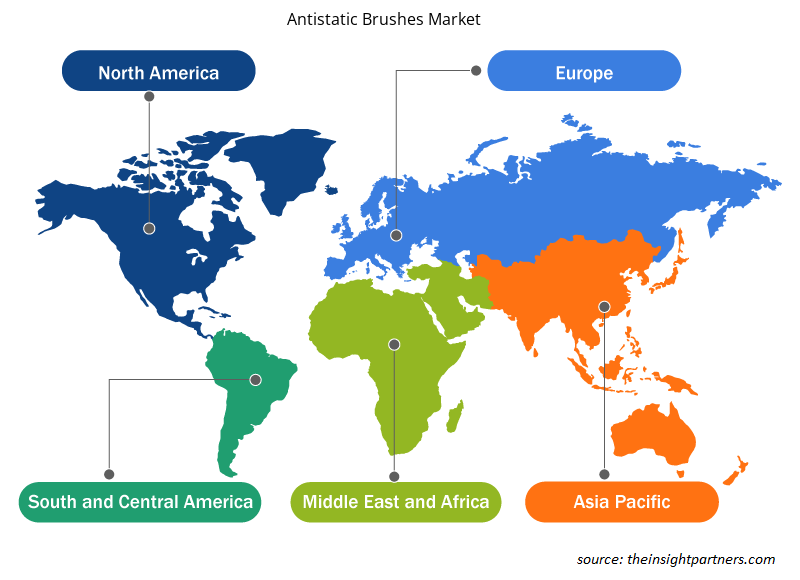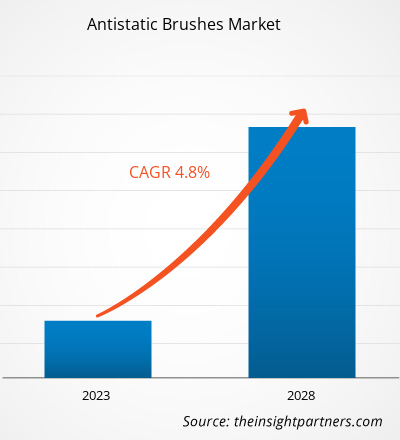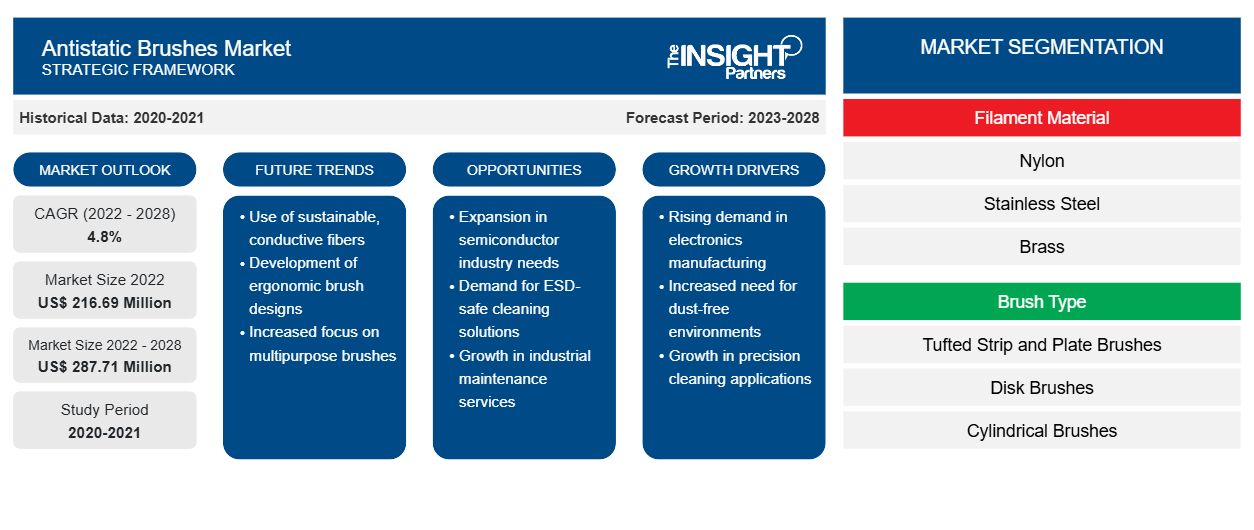[Rapporto di ricerca] Si prevede che il mercato delle spazzole antistatiche crescerà da 216,69 milioni di dollari nel 2022 a 287,71 milioni di dollari entro il 2028; si stima che registrerà un CAGR del 4,8% dal 2022 al 2028.
ANALISI DI MERCATO
Le spazzole antistatiche sono piccole spazzole conduttive portatili con setole adatte per la pulizia sicura di circuiti stampati e altri componenti elettrici soggetti a danni da scariche elettrostatiche. I materiali filamentari utilizzati per realizzare le spazzole antistatiche includono nylon, acciaio inossidabile, ottone, alluminio, fibra di carbonio, pelo di capra, crine di cavallo, pelo di maiale, tampico , bronzo fosforoso, pelo di cammello e pelo di bue. I produttori presenti sul mercato offrono diversi tipi di spazzole antistatiche , come spazzole a strisce e a piastre, spazzole a disco, spazzole cilindriche e spazzole portatili. Le spazzole antistatiche personalizzate sono disponibili in numerose dimensioni e forme.
FATTORI DI CRESCITA E SFIDE
L'industria elettronica è una delle più grandi e in più rapida crescita al mondo. I componenti elettronici sono altamente sensibili all'elettricità statica. Durante il processo di produzione, le cariche statiche possono accumularsi sulle superfici dei componenti, delle schede di circuito o delle apparecchiature di assemblaggio. Se non controllate in modo efficace, le scariche elettrostatiche ( ESD ) possono danneggiare queste parti elettroniche sensibili, con conseguenti guasti del prodotto, riduzione dell'affidabilità e aumento dei costi. Inoltre, il rischio di danni statici aumenta con la continua miniaturizzazione dei dispositivi elettronici. I componenti miniaturizzati sono più sensibili alle ESD a causa delle loro dimensioni ridotte e della maggiore sensibilità. Le spazzole antistatiche vengono utilizzate per dissipare le cariche statiche e prevenire le ESD , garantendo l'integrità e la qualità dei prodotti elettronici. Sebbene le spazzole antistatiche siano soluzioni efficaci, convenienti e convenienti per il controllo statico, la disponibilità di metodi e tecnologie alternative per il controllo statico può frenarne l'adozione in diversi settori. Ionizzatori, spray antistatico , fasce da polso, rivestimenti antistatici , rivestimenti conduttivi e sistemi di messa a terra specializzati sono alternative comunemente utilizzate alle spazzole antistatiche . Diversi approcci adottati da questi prodotti per controllare il controllo statico possono fornire vantaggi in applicazioni o settori specifici. Inoltre, alcuni settori o applicazioni possono richiedere soluzioni di controllo statico specializzate e su misura per le loro esigenze specifiche. Di conseguenza, possono optare per sistemi o apparecchiature di controllo statico personalizzati che integrano misure di controllo statico direttamente nei loro processi di produzione.
Personalizza questo report in base alle tue esigenze
Riceverai la personalizzazione gratuita di qualsiasi report, comprese parti di questo report, o analisi a livello nazionale, pacchetto dati Excel, oltre a usufruire di grandi offerte e sconti per start-up e università
-
Scopri le principali tendenze di mercato in questo rapporto.Questo campione GRATUITO includerà analisi di dati che spaziano dalle tendenze di mercato alle stime e alle previsioni.
SEGMENTAZIONE E AMBITO DEL REPORT
"Global Antistatic Brushes Market Analysis to 2030" è uno studio specializzato e approfondito con un focus principale sulle tendenze del mercato globale delle spazzole antistatiche e sulle opportunità di crescita. Il rapporto mira a fornire una panoramica del mercato globale delle spazzole antistatiche con una segmentazione di mercato dettagliata in base al materiale del filamento, al tipo di spazzole, all'applicazione e alla geografia. Il mercato globale delle spazzole antistatiche ha assistito a una forte crescita negli ultimi anni e si prevede che continuerà questa tendenza durante il periodo di previsione. Il rapporto fornisce statistiche chiave sul consumo di spazzole antistatiche in tutto il mondo insieme alla loro domanda nelle principali regioni e paesi. Inoltre, il rapporto fornisce una valutazione qualitativa di vari fattori che influenzano le prestazioni del mercato delle spazzole antistatiche nelle principali regioni e paesi. Il rapporto include anche un'analisi completa dei principali attori nel mercato delle spazzole antistatiche e dei loro principali sviluppi strategici. Sono incluse anche diverse analisi sulle dinamiche di mercato per aiutare a identificare i principali fattori trainanti, le tendenze di mercato e le redditizie opportunità di mercato delle spazzole antistatiche che, a loro volta, aiuterebbero a identificare le principali sacche di entrate.
Inoltre, l'analisi dell'ecosistema e l'analisi delle cinque forze di Porter forniscono una visione a 360 gradi del mercato globale delle spazzole antistatiche, che aiuta a comprendere l'intera filiera e i vari fattori che influenzano la crescita del mercato.
ANALISI SEGMENTALE
Il mercato globale delle spazzole antistatiche è segmentato in base al materiale del filamento, al tipo di spazzola e all'applicazione. In base al materiale del filamento, il mercato è segmentato in nylon, acciaio inossidabile, ottone, alluminio, fibra di carbonio e altri. In termini di tipo di spazzola, il mercato delle spazzole antistatiche è segmentato in spazzole a strisce e a piastre tufted, spazzole a disco, spazzole cilindriche e altri. In base all'applicazione, il mercato è segmentato in automotive, lavorazione dei metalli, elettronica, macchinari industriali e altri.
La quota di mercato delle spazzole antistatiche per il segmento in acciaio inossidabile è stata la più grande nel 2022. L'acciaio inossidabile è resistente al calore, alla ruggine e alla corrosione ed è compatibile con applicazioni a umido e a secco. Le spazzole con setole in acciaio inossidabile sono ampiamente utilizzate nelle applicazioni conduttive e in camera bianca per dissipare le cariche statiche. L'acciaio inossidabile ha una buona duttilità e può essere formato in filamenti fini o ultrafini. Inoltre, la quota di mercato delle spazzole antistatiche per il segmento delle spazzole a strisce e a piastra tufted è stata la più grande. Il nucleo e le setole sono i componenti principali delle spazzole tufted. Il nucleo della spazzola tufted è realizzato in plastica o legno con fori progettati per contenere le setole. Le setole sono gruppi di filamenti tenuti in posizione da graffette, fili o resine epossidiche. Le spazzole tufted e le spazzole a piastra hanno varie forme, dimensioni e tipi di filamenti. Inoltre, in termini di applicazione, il segmento dei macchinari industriali ha rappresentato una quota significativa del mercato delle spazzole antistatiche. I macchinari industriali sono uno dei principali settori applicativi delle spazzole antistatiche. Queste spazzole sono ampiamente utilizzate nelle macchine per avvolgimento bagagli, macchine per imballaggio, macchine per laminazione, macchine da stampa, macchine per etichettatura e codifica, macchine da taglio e così via. Le spazzole antistatiche in fibra di carbonio sono comunemente utilizzate per eliminare l'elettricità statica nelle industrie della plastica e della carta.
ANALISI REGIONALE
Il rapporto fornisce una panoramica dettagliata del mercato delle spazzole antistatiche rispetto a cinque regioni principali, vale a dire Nord America, Europa, Asia Pacifico (APAC), Medio Oriente e Africa (MEA) e Sud e Centro America. L'Asia Pacifico ha rappresentato la quota maggiore del mercato delle spazzole antistatiche nel 2022. La domanda di spazzole antistatiche nell'Asia Pacifico è parallela alle crescenti dimensioni dell'industrializzazione e della produzione di veicoli. Nell'ambito degli Obiettivi di sviluppo sostenibile 2030, la Banca asiatica di sviluppo ha pianificato di costruire infrastrutture resilienti, promuovere un'industrializzazione inclusiva e sostenibile e favorire l'innovazione nell'Asia Pacifico. Inoltre, l'aumento del numero di veicoli in flotta in paesi come Cina, India e Corea del Sud sta alimentando la domanda di PCB e semiconduttori, rafforzando ulteriormente la necessità di spazzole antistatiche. L'Europa ha rappresentato una quota significativa del mercato globale delle spazzole antistatiche; il mercato in questa regione è valutato a oltre 50 milioni di dollari nel 2022. La fiorente industria automobilistica nella regione favorisce la crescita del mercato delle spazzole antistatiche. Secondo la Commissione Europea (UE), l'Europa è tra i maggiori produttori di veicoli a motore al mondo. Pertanto, l'industria automobilistica è una delle industrie in più rapida crescita e più importanti nell'economia europea.
SVILUPPI DEL SETTORE E OPPORTUNITÀ FUTURE
Partnership, acquisizioni e lanci di nuovi prodotti sono state le principali strategie adottate dai player che operano nel mercato globale delle spazzole antistatiche. Diversi settori hanno sfide uniche in termini di controllo statico e preferiscono spazzole specificamente progettate per soddisfare le loro esigenze. Ad esempio, nel settore dell'elettronica, le spazzole potrebbero dover avere un certo livello di morbidezza per evitare danni ai delicati componenti elettronici. D'altro canto, in un ambiente di camera bianca, le spazzole potrebbero richiedere specifiche certificazioni di pulizia. Pertanto, la domanda di spazzole antistatiche su misura per applicazioni e requisiti specifici continuerebbe a crescere con la specializzazione e la diversificazione nei settori. Ottimizzando aspetti come il materiale della spazzola, il tipo di setola, la densità, la lunghezza e la forma, i produttori possono ottimizzare le spazzole per applicazioni specifiche. Esistono diversi produttori di spazzole antistatiche che offrono servizi di personalizzazione e ricondizionamento. Ad esempio, Gordon Brush Mfg Co Inc fornisce servizi di personalizzazione per soddisfare particolari requisiti dei clienti.
Approfondimenti regionali sul mercato delle spazzole antistatiche
Le tendenze regionali e i fattori che influenzano il mercato delle spazzole antistatiche durante il periodo di previsione sono stati ampiamente spiegati dagli analisti di Insight Partners. Questa sezione discute anche i segmenti e la geografia del mercato delle spazzole antistatiche in Nord America, Europa, Asia Pacifico, Medio Oriente e Africa e America meridionale e centrale.

- Ottieni i dati specifici regionali per il mercato delle spazzole antistatiche
Ambito del rapporto di mercato sulle spazzole antistatiche
| Attributo del report | Dettagli |
|---|---|
| Dimensioni del mercato nel 2022 | 216,69 milioni di dollari USA |
| Dimensioni del mercato entro il 2028 | 287,71 milioni di dollari USA |
| CAGR globale (2022 - 2028) | 4,8% |
| Dati storici | 2020-2021 |
| Periodo di previsione | 2023-2028 |
| Segmenti coperti |
Per materiale del filamento
|
| Regioni e Paesi coperti |
America del Nord
|
| Leader di mercato e profili aziendali chiave |
|
Densità dei player del mercato delle spazzole antistatiche: comprendere il suo impatto sulle dinamiche aziendali
Il mercato delle spazzole antistatiche sta crescendo rapidamente, spinto dalla crescente domanda degli utenti finali dovuta a fattori quali l'evoluzione delle preferenze dei consumatori, i progressi tecnologici e una maggiore consapevolezza dei vantaggi del prodotto. Con l'aumento della domanda, le aziende stanno ampliando le loro offerte, innovando per soddisfare le esigenze dei consumatori e capitalizzando sulle tendenze emergenti, il che alimenta ulteriormente la crescita del mercato.
La densità degli operatori di mercato si riferisce alla distribuzione di aziende o società che operano in un particolare mercato o settore. Indica quanti concorrenti (operatori di mercato) sono presenti in un dato spazio di mercato in relazione alle sue dimensioni o al valore di mercato totale.
Le principali aziende che operano nel mercato delle spazzole antistatiche sono:
- Gordon Brush Mfg Co Inc
- La Industrial Brush Co Inc
- Precision Brush Co
- Azienda di spazzole Cocker-Weber
- Spazzole a spirale Inc.
Disclaimer : le aziende elencate sopra non sono classificate secondo un ordine particolare.

- Ottieni una panoramica dei principali attori del mercato delle spazzole antistatiche
IMPATTO DEL COVID/IMPATTO DELLO SCENARIO GEOPOLITICO/IMPATTO DELLA RECESSIONE
La pandemia di COVID-19 ha portato a un declino nei progressi di molti settori in tutto il mondo. Automotive, componenti elettrici ed elettronici, semiconduttori e lavorazione dei metalli sono stati tra i principali settori che hanno guidato la crescita del mercato delle spazzole antistatiche. Nel 2020, questi settori hanno dovuto sospendere le loro attività a causa di interruzioni della catena del valore causate dalle restrizioni sui confini nazionali e internazionali. La pandemia ha causato il caos nel settore stabile delle spazzole antistatiche. La carenza di manodopera ha portato alla decelerazione delle operazioni di produzione e distribuzione delle spazzole antistatiche. Le interruzioni nella catena di fornitura globale e la chiusura degli impianti di produzione hanno ostacolato la crescita del mercato delle spazzole antistatiche.
Nel 2021, il mercato globale ha iniziato a riprendersi dalle perdite subite nel 2020, poiché i governi di diversi paesi hanno annunciato un allentamento delle restrizioni sociali. I produttori hanno potuto operare a piena capacità, il che li ha aiutati a superare il divario tra domanda e offerta. Inoltre, l'aumento dei tassi di vaccinazione ha contribuito a migliorare le condizioni generali in diversi paesi, il che ha portato a contesti favorevoli al progresso industriale e commerciale. Questi fattori hanno aumentato la crescita del mercato delle spazzole antistatiche in diverse regioni nel periodo di ripresa post-pandemia.
PANORAMA COMPETITIVO E AZIENDE CHIAVE
Tra i player che operano nel mercato delle spazzole antistatiche ci sono Gordon Brush Mfg Co Inc, The Industrial Brush Co Inc, Precision Brush Co, Cocker-Weber Brush Co, Spiral Brushes Inc, Amstat Industries Inc, Ultrafab Inc, KOTI Industrial and Technical Brushes BV, Westmont Inc e KIST + ESCHERICH GmbH. I principali player che operano in questo mercato si concentrano sulla fornitura di prodotti di alta qualità per soddisfare la domanda dei clienti.
- Analisi storica (2 anni), anno base, previsione (7 anni) con CAGR
- Analisi PEST e SWOT
- Valore/volume delle dimensioni del mercato - Globale, Regionale, Nazionale
- Industria e panorama competitivo
- Set di dati Excel
Report recenti
Testimonianze
Motivo dell'acquisto
- Processo decisionale informato
- Comprensione delle dinamiche di mercato
- Analisi competitiva
- Analisi dei clienti
- Previsioni di mercato
- Mitigazione del rischio
- Pianificazione strategica
- Giustificazione degli investimenti
- Identificazione dei mercati emergenti
- Miglioramento delle strategie di marketing
- Aumento dell'efficienza operativa
- Allineamento alle tendenze normative























 Ottieni un campione gratuito per - Mercato delle spazzole antistatiche
Ottieni un campione gratuito per - Mercato delle spazzole antistatiche